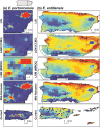Climate as a driver of tropical insular diversity: comparative phylogeography of two ecologically distinctive frogs in Puerto Rico
- PMID: 26508809
- PMCID: PMC4620057
- DOI: 10.1111/ecog.01327
Climate as a driver of tropical insular diversity: comparative phylogeography of two ecologically distinctive frogs in Puerto Rico
Abstract
The effects of late Quaternary climate on distributions and evolutionary dynamics of insular species are poorly understood in most tropical archipelagoes. We used ecological niche models under past and current climate to derive hypotheses regarding how stable climatic conditions shaped genetic diversity in two ecologically distinctive frogs in Puerto Rico. Whereas the Mountain Coquí, Eleutherodactylus portoricensis, is restricted to montane forest in the Cayey and Luquillo Mountains, the Red-eyed Coquí, E. antillensis, is a habitat generalist distributed across the entire Puerto Rican Bank (Puerto Rico and the Virgin Islands, excluding St. Croix). To test our hypotheses, we conducted phylogeographic and population genetic analyses based on mitochondrial and nuclear loci of each species across their range in Puerto Rico. Patterns of population differentiation in E. portoricensis, but not in E. antillensis, supported our hypotheses. For E. portoricensis, these patterns include: individuals isolated by long-term unsuitable climate in the Río Grande de Loíza Basin in eastern Puerto Rico belong to different genetic clusters; past and current climate strongly predicted genetic differentiation; and Cayey and Luquillo Mountains populations split prior to the last interglacial. For E. antillensis, these patterns include: genetic clusters did not fully correspond to predicted long-term unsuitable climate; and past and current climate weakly predicted patterns of genetic differentiation. Genetic signatures in E. antillensis are consistent with a recent range expansion into western Puerto Rico, possibly resulting from climate change and anthropogenic influences. As predicted, regions with a large area of long-term suitable climate were associated with higher genetic diversity in both species, suggesting larger and more stable populations. Finally, we discussed the implications of our findings for developing evidence-based management decisions for E. portoricensis, a taxon of special concern. Our findings illustrate the role of persistent suitable climatic conditions in promoting the persistence and diversification of tropical island organisms.
Figures




Similar articles
-
ORIGINS AND GENETIC DIVERSITY OF INTRODUCED POPULATIONS OF THE PUERTO RICAN RED-EYED COQUÍ, ELEUTHERODACTYLUS ANTILLENSIS, IN SAINT CROIX (U.S. VIRGIN ISLANDS) AND PANAMÁ.Copeia. 2017 Jul;105(2):220-228. doi: 10.1643/CG-16-501. Epub 2017 Jun 2. Copeia. 2017. PMID: 28649148 Free PMC article.
-
Sea level, topography and island diversity: phylogeography of the Puerto Rican Red-eyed Coquí, Eleutherodactylus antillensis.Mol Ecol. 2012 Dec;21(24):6033-52. doi: 10.1111/mec.12020. Epub 2012 Nov 19. Mol Ecol. 2012. PMID: 23163292
-
Population Declines of Mountain Coqui (Eleutherodactylus portoricensis) in the Cordillera Central of Puerto Rico.Herpetol Conserv Biol. 2014 Dec 31;9(3):578-589. Herpetol Conserv Biol. 2014. PMID: 25685250 Free PMC article.
-
Climatic stability and genetic divergence in the tropical insular lizard Anolis krugi, the Puerto Rican 'Lagartijo Jardinero de la Montaña'.Mol Ecol. 2010 May;19(9):1860-76. doi: 10.1111/j.1365-294X.2010.04616.x. Epub 2010 Apr 6. Mol Ecol. 2010. PMID: 20374489
-
The big potential of the small frog Eleutherodactylus coqui.Elife. 2022 Jan 14;11:e73401. doi: 10.7554/eLife.73401. Elife. 2022. PMID: 35029143 Free PMC article. Review.
Cited by
-
Reassessing rainfall in the Luquillo Mountains, Puerto Rico: Local and global ecohydrological implications.PLoS One. 2017 Jul 7;12(7):e0180987. doi: 10.1371/journal.pone.0180987. eCollection 2017. PLoS One. 2017. PMID: 28686734 Free PMC article.
-
ORIGINS AND GENETIC DIVERSITY OF INTRODUCED POPULATIONS OF THE PUERTO RICAN RED-EYED COQUÍ, ELEUTHERODACTYLUS ANTILLENSIS, IN SAINT CROIX (U.S. VIRGIN ISLANDS) AND PANAMÁ.Copeia. 2017 Jul;105(2):220-228. doi: 10.1643/CG-16-501. Epub 2017 Jun 2. Copeia. 2017. PMID: 28649148 Free PMC article.
-
Environmentally driven phenotypic convergence and niche conservatism accompany speciation in hoary bats.Sci Rep. 2022 Dec 19;12(1):21877. doi: 10.1038/s41598-022-26453-y. Sci Rep. 2022. PMID: 36536003 Free PMC article.
-
Shaping of topography by topographically-controlled vegetation in tropical montane rainforest.PLoS One. 2023 Mar 9;18(3):e0281835. doi: 10.1371/journal.pone.0281835. eCollection 2023. PLoS One. 2023. PMID: 36893140 Free PMC article.
References
-
- Angulo A. Eleutherodactylus portoricensis. IUCN 2013 IUCN Red List of Threatened Species Version 2013.2. 2008 www.iucnredlist.org. Downloaded on 06 May 2014.
-
- Austerlitz F, et al. Evolution of coalescence times, genetic diversity and structure during colonization. Theor Popul Biol. 1997;51:148–164.
-
- Barker BS, et al. Sea level, topography, and island diversity: phylogeography of the Puerto Rican Red-eyed Coquí, Eleutherodactylus antillensis. Mol Ecol. 2012;21:6033–6052. - PubMed
-
- Barker BS, et al. Deep intra-island divergence of a montane forest endemic: phylogeography of the Puerto Rican frog Eleutherodactylus portoricensis (Anura: Eleutherodactylidae) J Biogeogr. 2011;38:2311–2325.
Grants and funding
LinkOut - more resources
Full Text Sources
Other Literature Sources
Research Materials
Miscellaneous
